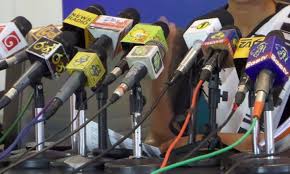Sri Lanka Ministry of Media has made its zero draft of ” National Media Policy” available to media organisations.
Read the Draft here: National Media Policy Zero Draft (final) English
Here is a summary provided by Microsoft AI
Analysis of National Media policy July 25
“Zero Draft National Media Policy of Sri Lanka” (dated 18 July 2024)
Freedom of Expression: Strengths, Weaknesses, and Risks
Strengths (Positive Aspects)
1. Clear Affirmation of Rights – The policy explicitly affirms freedom of expression and media freedom as constitutional and international rights (Articles 14(1)(a) and 14A). – Recognizes that expression includes not just agreeable views, but also those that “offend, shock or disturb”—aligning with international human rights jurisprudence (e.g., European Court of Human Rights).
2. Media Pluralism and Diversity – Strong emphasis on media pluralism, with commitments to ensure diverse ownership, viewpoints, and access, especially for marginalized voices
3. Editorial Independence – Acknowledges that journalistic independence is a public good, and editorial decisions should be free from interference by owners, advertisers, or government officials.
4. Safety of Journalists – Explicit commitment to creating safe working environments free from physical, legal, and digital harassment, and ending impunity for violence against journalists.
5. Media Accountability Through Co-Regulation – Suggests a co-regulation model (state + civil society) to avoid the extremes of state control or ineffective self-regulation—potentially a healthy balance if implemented independently.
6. Legal Reform Commitment – Recognizes the need to review outdated media laws, some dating back to colonial times, and reform them to align with modern digital realities and international standards.
Potential Concerns & Risks
1. Role of the Ministry of Mass Media – While the policy promotes independence, implementation, coordination, and oversight are led by the Ministry, which could lead to conflicts of interest, especially under governments that historically influence state media.
2. Ambiguity in Restrictions – The policy restates Article 15(2) of the Constitution which allows restrictions on expression in the interest of “racial and religious harmony” and other vague terms. These can be misused to stifle dissent or minority voices unless narrowly defined in practice.
3. Lack of Legal Safeguards – The draft does not yet contain concrete legal or institutional safeguards to ensure independence of media regulatory mechanisms, especially in politically sensitive contexts like elections.
4. Editorial Independence May Be Undermined Without Legal Backing – The commitment to editorial independence is policy-level only; without legal protections, this is vulnerable to erosion under different regimes.
5. Unclear Oversight of State Media – No concrete measures are proposed to transform state-owned broadcasters (e.g., SLRC, SLBC) into truly independent public service media. These remain prone to government control.
6. Lack of Mechanism for Enforcing Ethical Standards – While ethical conduct is promoted, the enforcement mechanisms remain underdeveloped. For example, public complaints mechanisms and transparency in complaints adjudication need more specificity.
7. Online Content Regulation and Foreign Platform Engagement – Engagement with global tech companies is encouraged, but the lack of jurisdiction and absence of a clear digital expression framework could open the door to unilateral blocking or surveillance if laws are later passed without consultation.
Conclusion From a freedom of expression perspective, this draft policy is aspirational and progressive in many areas—particularly in its recognition of rights, need for pluralism, and push for co-regulation. However, the real test lies in implementation. Without strong legal protections, independent institutions, and insulation from political influence, the policy could either stagnate or be selectively enforced. This is especially true given Sri Lanka’s history of media repression and politicized media governance**.
Recommendations for Strengthening Freedom of Expression – Enshrine editorial independence and co-regulation in law, not just policy. – Establish a truly independent media regulatory body with safeguards against political interference
– Create public service charters for state broadcasters, with transparent appointment and funding mechanisms. – Narrowly define any restrictions on expression to prevent misuse. – Involve civil society and journalist associations in ongoing oversight and review.
Zero Draft National Media Policy of Sri Lanka (dated 18 July 2024) from a freedom of expression perspective:
Key Strengths
Affirmation of Rights: Recognizes media freedom as a constitutional and international right, including speech that may be controversial.
Media Pluralism: Supports diverse ownership and perspectives, particularly for marginalized communities.
– Editorial Independence: Acknowledges journalistic autonomy as vital, protecting media from undue influence.
– Journalist Safety: Pledges to safeguard reporters from threats, harassment, and violence.
– Co-Regulation Approach: Suggests joint oversight by state and civil society to balance governance.
– Legal Reform Commitment: Plans to modernize outdated media laws to reflect digital realities.
Potential Risks & Weaknesses
– Ministry Oversight: Despite promoting independence, media governance remains under ministerial control, raising concerns over political influence.
– Vague Speech Restrictions:Broad limitations on expression (e.g., racial/religious harmony) could be misused to suppress dissent.
– Lack of Legal Protections:No strong legal mechanisms guarantee independent media regulation.
– State Media Oversight: No concrete proposals to ensure government-owned broadcasters operate free from political control.
– Ethics Enforcement Gaps: No detailed mechanisms for enforcing ethical journalism standards.
-Online Regulation Concerns: Lack of clear digital framework raises risks of government control over tech platforms.
Conclusion
The policy reflects progressive aspirations, emphasizing media freedom and pluralism. However, its success hinges on effective implementation and legal safeguards. Without independent institutions and strong protections, risks of political interference remain.
Recommendations for Strengthening
– Legal backing for editorial independence and regulatory co-governance.
– Establishing an independent media oversight body.
– Defining state broadcaster roles clearly to prevent government control.
– Refining speech restrictions to prevent abuse.
– Engaging civil society in continuous media governance review.
This draft policy presents an important step forward, but implementation challenges remain.
AI-generated summaries may not be completely accurate. Please refer to the original document when quoting.
